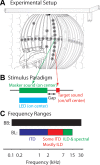Effects of forward masking on sound localization in cats: basic findings with broadband maskers
- PMID: 23843432
- PMCID: PMC4042416
- DOI: 10.1152/jn.00255.2013
Effects of forward masking on sound localization in cats: basic findings with broadband maskers
Abstract
Forward masking is traditionally measured with a detection task in which the addition of a preceding masking sound results in an increased signal-detection threshold. Little is known about the influence of forward masking on localization of free-field sound for human or animal subjects. Here we recorded gaze shifts of two head-unrestrained cats during localization using a search-coil technique. A broadband (BB) noise masker was presented straight ahead. A brief signal could come from 1 of the 17 speaker locations in the frontal hemifield. The signal was either a BB or a band-limited (BL) noise. For BB targets, the presence of the forward masker reduced localization accuracy at almost all target levels (20 to 80 dB SPL) along both horizontal and vertical dimensions. Temporal decay of masking was observed when a 15-ms interstimulus gap was added between the end of the masker and the beginning of the target. A large effect of forward masking was also observed for BL targets with low (0.2-2 kHz) and mid (2-7 kHz) frequencies, indicating that the interaural timing cue is susceptible to forward masking. Except at low sound levels, a small or little effect was observed for high-frequency (7-15 kHz) targets, indicating that the interaural level and the spectral cues in that frequency range remained relatively robust. Our findings suggest that different localization mechanisms can operate independently in a complex listening environment.
Keywords: ILD; ITD; forward masking; free-field; localization.
Figures












Similar articles
-
The role of spectral composition of sounds on the localization of sound sources by cats.J Neurophysiol. 2013 Mar;109(6):1658-68. doi: 10.1152/jn.00358.2012. Epub 2012 Dec 28. J Neurophysiol. 2013. PMID: 23274314 Free PMC article.
-
Spatial hearing ability of the pigmented Guinea pig (Cavia porcellus): Minimum audible angle and spatial release from masking in azimuth.Hear Res. 2018 Aug;365:62-76. doi: 10.1016/j.heares.2018.04.011. Epub 2018 Apr 27. Hear Res. 2018. PMID: 29778290 Free PMC article.
-
Growth of forward masking for sinusoidal and noise maskers as a function of signal delay; implications for suppression in noise.J Acoust Soc Am. 1983 Apr;73(4):1249-59. doi: 10.1121/1.389273. J Acoust Soc Am. 1983. PMID: 6853836
-
Effects of masker frequency and duration in forward masking: further evidence for the influence of peripheral nonlinearity.Hear Res. 2000 Dec;150(1-2):258-66. doi: 10.1016/s0378-5955(00)00206-9. Hear Res. 2000. PMID: 11077208 Review.
-
Behavioral studies of sound localization in the cat.J Neurosci. 1998 Mar 15;18(6):2147-60. doi: 10.1523/JNEUROSCI.18-06-02147.1998. J Neurosci. 1998. PMID: 9482800 Free PMC article. Review.
Cited by
-
Influence of double stimulation on sound-localization behavior in barn owls.J Comp Physiol A Neuroethol Sens Neural Behav Physiol. 2014 Dec;200(12):1033-44. doi: 10.1007/s00359-014-0953-8. Epub 2014 Oct 29. J Comp Physiol A Neuroethol Sens Neural Behav Physiol. 2014. PMID: 25352361
-
ON and OFF inhibition as mechanisms for forward masking in the inferior colliculus: a modeling study.J Neurophysiol. 2016 Jun 1;115(5):2485-500. doi: 10.1152/jn.00892.2015. Epub 2016 Feb 24. J Neurophysiol. 2016. PMID: 26912597 Free PMC article.
References
-
- Allen K, Alais D, Carlile S. Speech intelligibility reduces over distance from an attended location: evidence for an auditory spatial gradient of attention. Atten Percept Psychophys 71: 164–173, 2009 - PubMed
-
- Balakrishnan U, Freyman RL. Lateralization and detection of pulse trains with alternating interaural time delays. J Acoust Soc Am 112: 1605–1616, 2002 - PubMed
-
- Bekhterev NN, Vaitulevich SF, Nikitin NI, Shestopalova LB. Comparison of binaural release from forward masking in animals and humans. Electrophysiological studies. Neurosci Behav Physiol 32: 71–79, 2002 - PubMed
-
- Bernstein LR, Trahiotis C. Detection of interaural delay in high-frequency sinusoidally amplitude-modulated tones, two-tone complexes, and bands of noise. J Acoust Soc Am 95: 3561–3567, 1994 - PubMed
Publication types
MeSH terms
Grants and funding
LinkOut - more resources
Full Text Sources
Other Literature Sources
Miscellaneous

